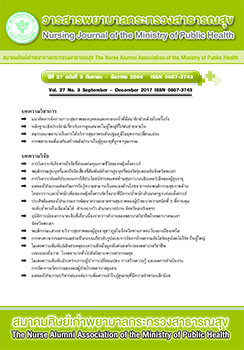Evidence-Based Practice on Endotracheal Suctioning for Intubated Adult Patients
Main Article Content
Abstract
Based on a literature review and nursing experiences, nurses have been shown to employ differentendotracheal suctioning methods. These methods may increase complications, such as hypoxia, changes in vital signs and pneumonia. The objective of this systematic review was to provide the available evidence on endotracheal suctioning for intubated adult patients. The suction procedure and nursing care reported in this article was divided into 3 steps.
1) Nursing practices before endotracheal suctioning included assessment of clinical indications to provide suction, selection of the suction catheter, giving high concentration oxygen before suctioning, increase in lung volume, and patient preparation.
2) Nursing practices during endotracheal suctioning included the use of sterile techniques, the duration of suctioning, the level of negative pressure of suctioning, the depth of the inserted catheter, the frequency of suctioning and suctioning skill.
3) Nursing evaluation after endotracheal suctioning included, the evaluation of the patient after suctioning and giving high concentration oxygen.
Nurses and other health care providers can utilize these practices as suctioning guidelines for intubated
adult patients to promote safety and reduce suctioning complications.
Article Details
บทความและรายงานวิจัยในวารสารพยาบาลกระทรวงสาธารณสุข เป็นความคิดเห็นของ ผู้เขียน มิใช่ของคณะผู้จัดทำ และมิใช่ความรับผิดชอบของสมาคมศิษย์เก่าพยาบาลกระทรวงสาธารณสุข ซึ่งสามารถนำไปอ้างอิงได้
References
2. Joffe AM, Deem SA. Physiologic and pathophysiologic responses to intubation. In C.A. Hagberg (Ed.), Benumof and Hagberg’s Airway Management. 3rd ed. Philadelphia, PA:Elsevier/Saunders; 2012. p. 184-200.
3. Pedersen, CM, Nielsen, MR, Hjermind J, Egerod I. Endotracheal suctioning of the adult intubated patient – what is the evidence? Journal of Intensive and Critical Care Nursing. 2009;25(1):21-30.
4. Kaplow R, Hardin SR. Critical care nursing: synergy for optimal outcome. Boston: Jones and Bartlett; 2007.
5. Finucane BT, Tsui BCH, Santora AH. Principles of airway management. 4th ed. Springer: New York; 2011. p. 683-730.
6. Kummatid A, Markrat M. Using the systematic review to provide a complete summary on a research question in Evidence-Based Practice: a 3-step method. The Southern College Network Journal of Nursing and Public Health 2016;3(3):246-59.(in Thai).
7. Joanna Briggs Institute. Reviewers’ Manual 2014 Edition. Australia: Solito Fine Colour Printers. [Internet]. 2014 [cited 2016 May 10]. Available from: http://joannabriggs.org/assets/docs/approach/JBI-Levels-of-evidence_2014.pdf.
8. Day T, Lles N, Griffiths P. Effects of performance feedback on tracheal suctioning knowledge and skills: randomized controlled trial. Journal of Advanced Nursing. 2009;65(7):1423-31.
9. American Association for Respiratory Care AARC Clinical Practice Guidelines. Endotracheal suctioning of mechanically ventilated patients with artificial airways 2010. Respir Care.2010;55(6):758-64.
10. Kuriakose SA. Using the synergy model as best practice in endotracheal tube suctioning of critically ill patients. Dimension of Critical Care Nursing. 2008;27(1):10-5.
11. Intensive Care Coordination and Monitoring Unit. Suctioning an adult ICU patient with an artificial airway: a clinical practice guideline. [Internet].2014 [cited 2016 May 10]. Available from:https://www.aci.health.nsw.gov.au/__data/assets/pdf_file/0010/239554/ACI14_Suction_2-2.pdf
12. Overend TJ, Anderson CM, Brooks D, Cicutto L, Keim M, McAuslan D, et.al. Updating the evidence-base for suctioning adult patients: a systematic review. Can Respir J. ;2009 (3):6-17.

